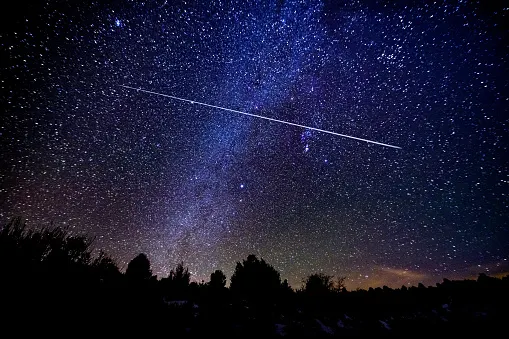
Look up for these amazing astronomical sights in the sky this Fall
Here's our night-sky guide for all of Fall 2020
Fall is an excellent time of year to get out under the stars with our nights becoming longer, and there are plenty of events to witness this season.
Multiple meteor showers grace the sky in Fall, including the fantastic Geminids meteor shower in December. A trio of micro Full Moons will be visible, as well, including the first Halloween Blue Moon we've had since 2001. Mars reaches its biggest and brightest early in the season. Saturn and Jupiter are still shining brightly, teaming up with the Moon for a few nights each month, and drawing closer together towards a Great Conjunction.
Read on!
FALL ASTRONOMY 2019
All season long - Jupiter and Saturn draw closer together
Sept 24-26: Moon near Jupiter and Saturn
Oct 1: Micro Full Moon
Oct 3: Moon very close to Mars
Oct 6: Mars closest approach for 2020
Oct 8: Draconid Meteor Shower peak
Oct 10: Southern Taurid Meteor Shower peak
Oct 13: Mars Opposition
Oct 14-28: Zodiacal Light in pre-dawn eastern sky
Oct 21: Orionid Meteor Shower peak
Oct 21-23: Moon near Jupiter and Saturn
Oct 31: Halloween Micro Hunter's Blue Moon
Nov 12: Northern Taurid Meteor Shower peak
Nov 14: Perigee New Moon (high tides expected)
Nov 16: Leonid Meteor Shower peak (nearly New Moon)
Nov 17-19: Moon near Jupiter and Saturn
Nov 29-30: Micro Beaver Moon Penumbral Lunar Eclipse
Dec 11: Venus close to Moon
Dec 13-14: Geminid Meteor Shower peak (New Moon!)
Dec 14: Total Solar Eclipse across South America
Dec 21: Winter Solstice and a Great Conjunction
Visit our Complete Guide to Fall 2020 for an in-depth look at the Fall Forecast, tips to plan for it and a sneak peek at the winter ahead
JUPITER, SATURN AND THE GREAT CONJUNCTION
Jupiter and Saturn have been a constant sight in our night skies so far in 2020, and that's not going to end anytime soon.
During the Spring and Summer, the two initially drew closer together, as they approached their 'Oppositions'. They then appeared to retreat from one another again, as our perspective changed, with Earth swinging around the Sun. Throughout the Fall, the two giant planets will again draw closer and closer together in our sky, setting up for a special event on December 21.
This event is known as a Great Conjunction, when Jupiter and Saturn line up perfectly when viewed from Earth. The last Great Conjunction was in May of 2000, but this particular one is special - it's the closest conjunction of Jupiter and Saturn in our sky since 1623!
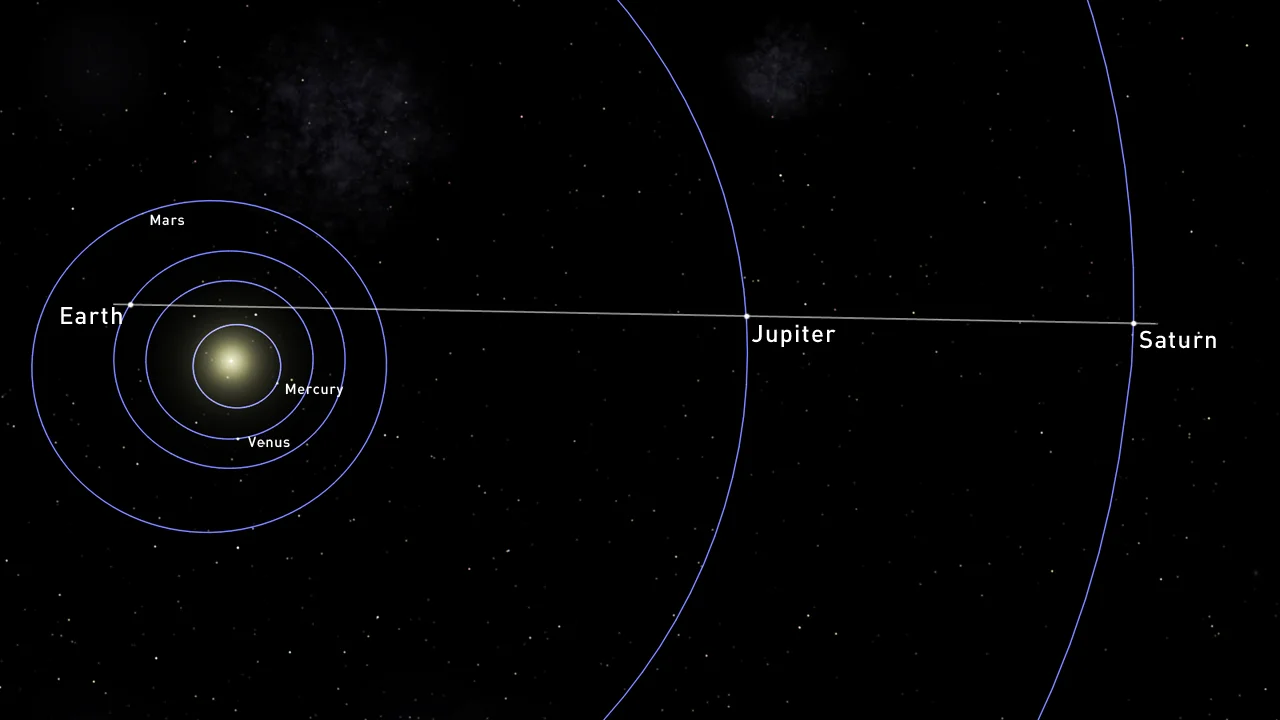
The alignment of Earth, Jupiter and Saturn on December 21, 2020, for the Great Conjunction! Credit: Celestia/Scott Sutherland
Since both Jupiter and Saturn will be on the other side of the Sun from Earth, seeing this for ourselves requires some planning. Keep watching the two as they appear in the southern sky at sunset each night, tracking farther and farther west throughout the season. Then, in the evening on December 21, find a good view of the western horizon and watch just after sunset to see these two "merged" together.
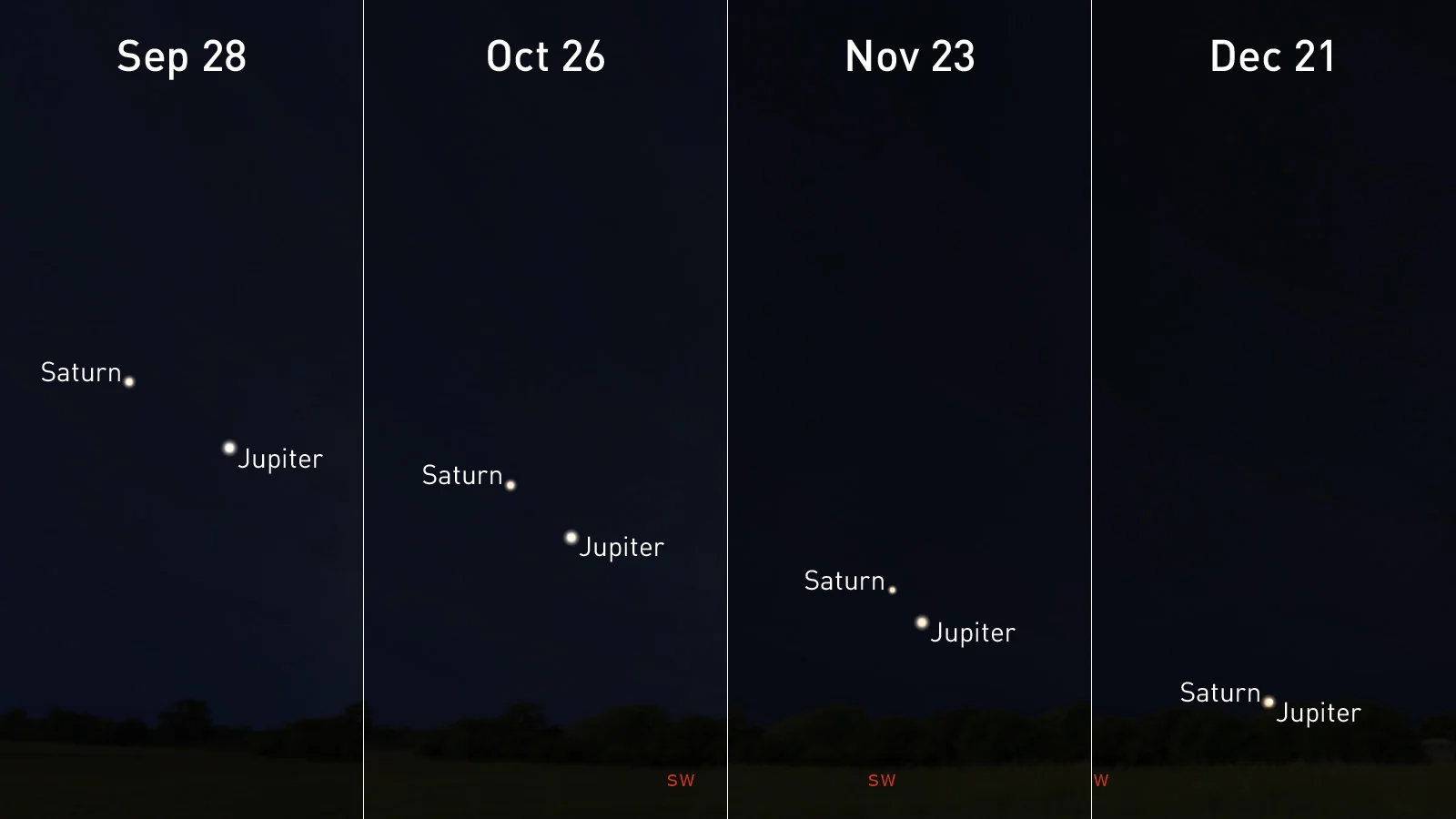
Jupiter and Saturn, in the southwestern sky, draw closer and closer between September and December, until they appear to merge. Credit: Stellarium/Scott Sutherland
Also, keep an eye on these two giant planets, as they team up with the Moon each month - first on September 24-26, then on October 21-23, and again on November 17-19.
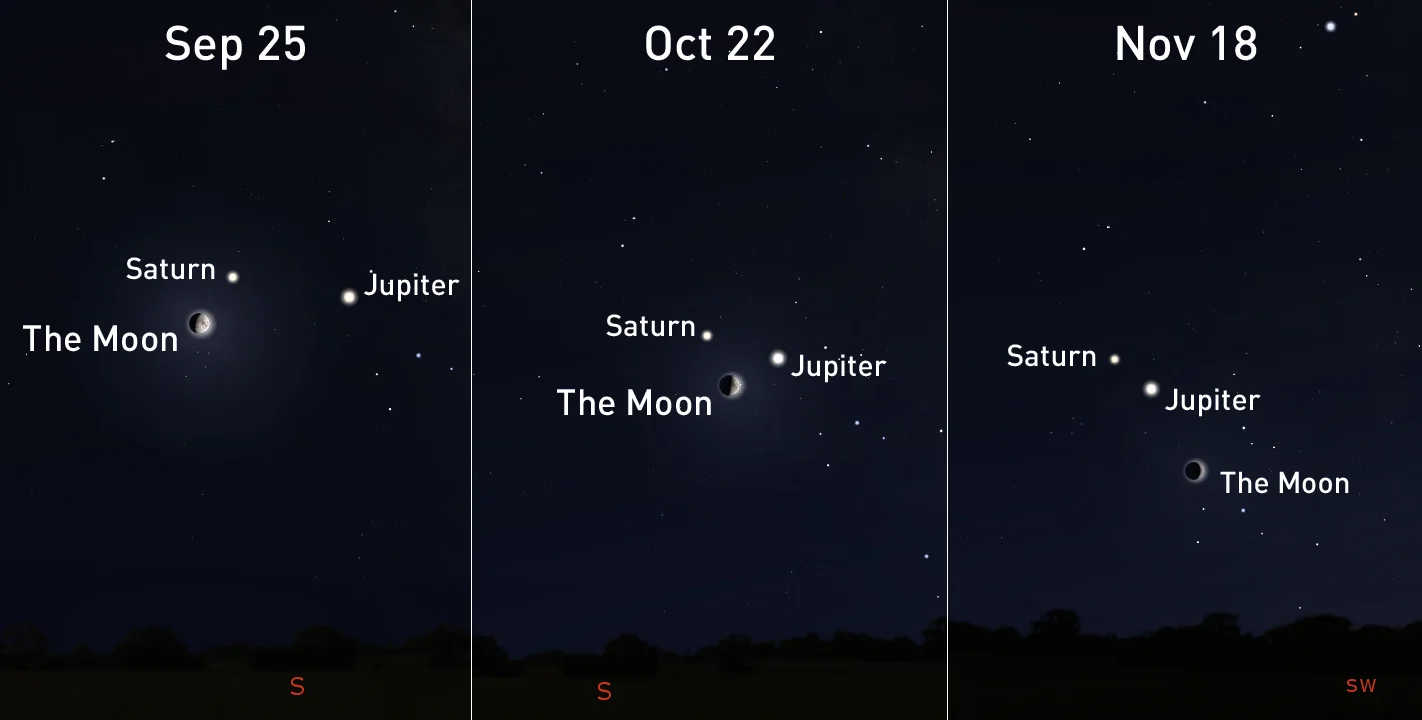
Watch for three conjunctions between Jupiter, Saturn and the Moon. On the night of December 21, while the Moon will be high in Credit: Stellarium/Scott Sutherland
On December 21, the Moon will be in the same part of the sky as these two planets. Still, they won't be anywhere near each other - with the Moon high up in the sky. Jupiter and Saturn merged or appearing to touch, very close to the western horizon.
A TRIO OF MICRO FULL MOONS
Starting on the first night of October, we will see three "micro Full Moons" this season.
We know a lot about supermoons. They occur when the Full or New Moon is near or at the closest point to Earth in the Moon's elliptical orbit. A 'micromoon' is the opposite - a Full or New Moon near or at its farthest point to Earth.
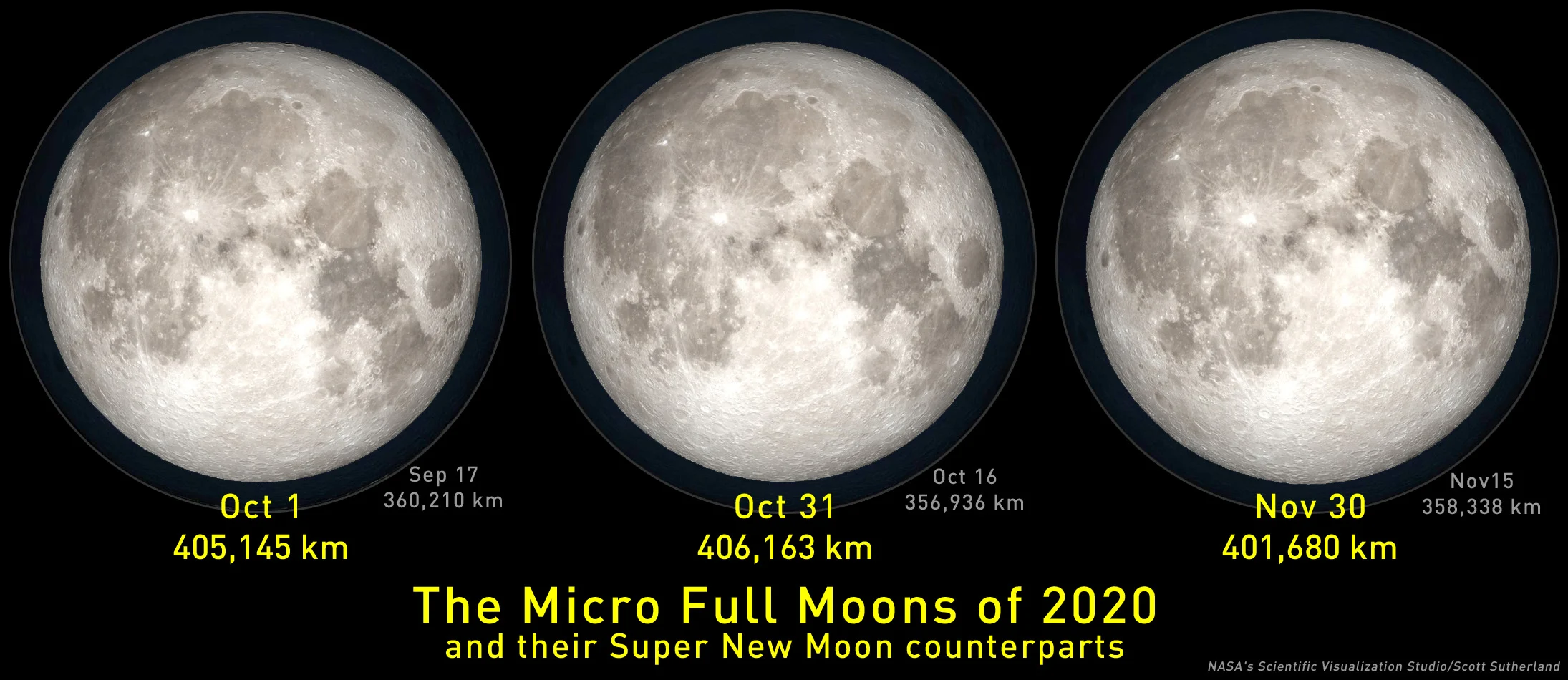
The three micro Full Moons of Fall 2020, with their corresponding Super New Moons in the background. Credit: NASA's Scientific Visualization Studio/Scott Sutherland
The three micromoons will be on October 1, October 31 and November 30. Of these, the October 31 Full Moon is extra special.
It is the first Halloween Full Moon since 2001 (and we won't see another until 2039). It is 2020's apogee Full Moon - the farthest, smallest and dimmest Full Moon of the year. It is also the second Full Moon in October's calendar month, making it a Blue Moon (by one definition).
So, it's a Halloween Hunter's Blue Micro Moon!
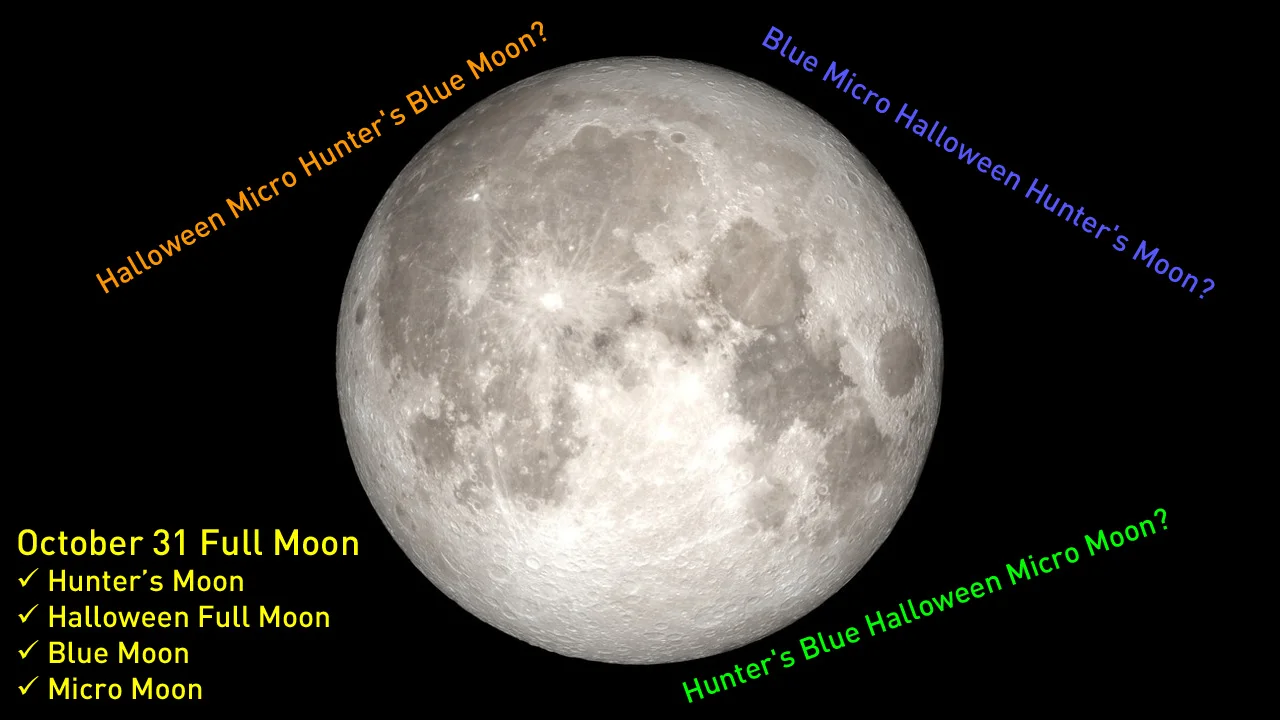
The October 31 Halloween Full Moon and its various possible names. Credit: NASA's Scientific Visualization Studio/Scott Sutherland
Note: a previous version of this article referred to the micromoons as 'minimoons'. While a 'micromoon' is typically used to refer to the opposite of a supermoon, 'minimoon' is most often used to describe an asteroid that becomes a temporary satellite of Earth.
OPPOSITION OF MARS
Mars has been growing brighter and brighter, night by night, throughout the year so far. On the night of October 6, the planet will reach its brightest, as it reaches its closest point to Earth in their orbits.
According to NASA, Mars will be 62.1 million kilometres away - the closest it's come since July of 2018.
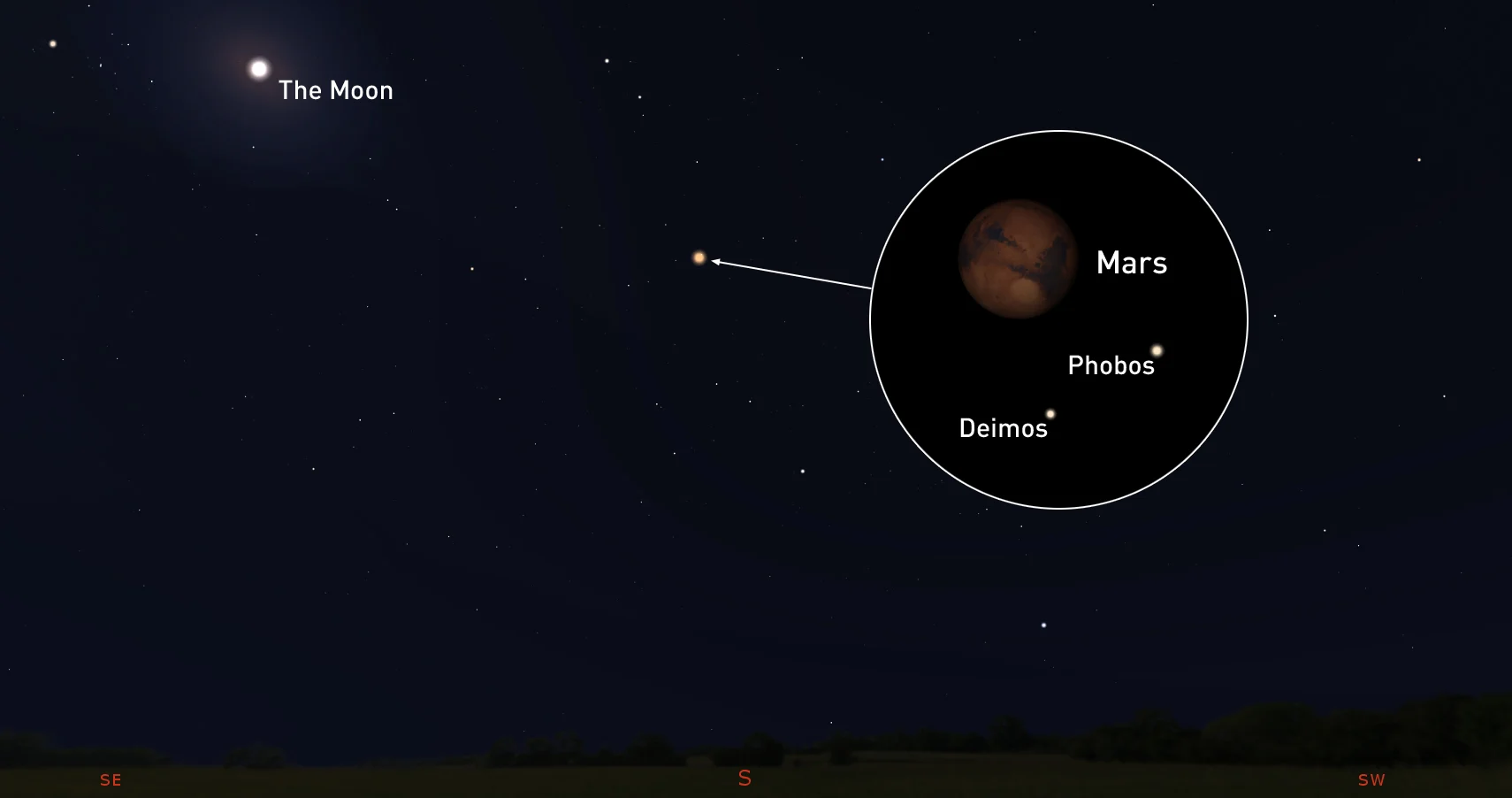
Mars closest approach, on October 6, with a telescopic view of what the planet and its two moons would like on that night. Credit: Stellarium/Scott Sutherland
Mars Opposition - when Earth is directly between Mars and the Sun - occurs several days later, on October 13.
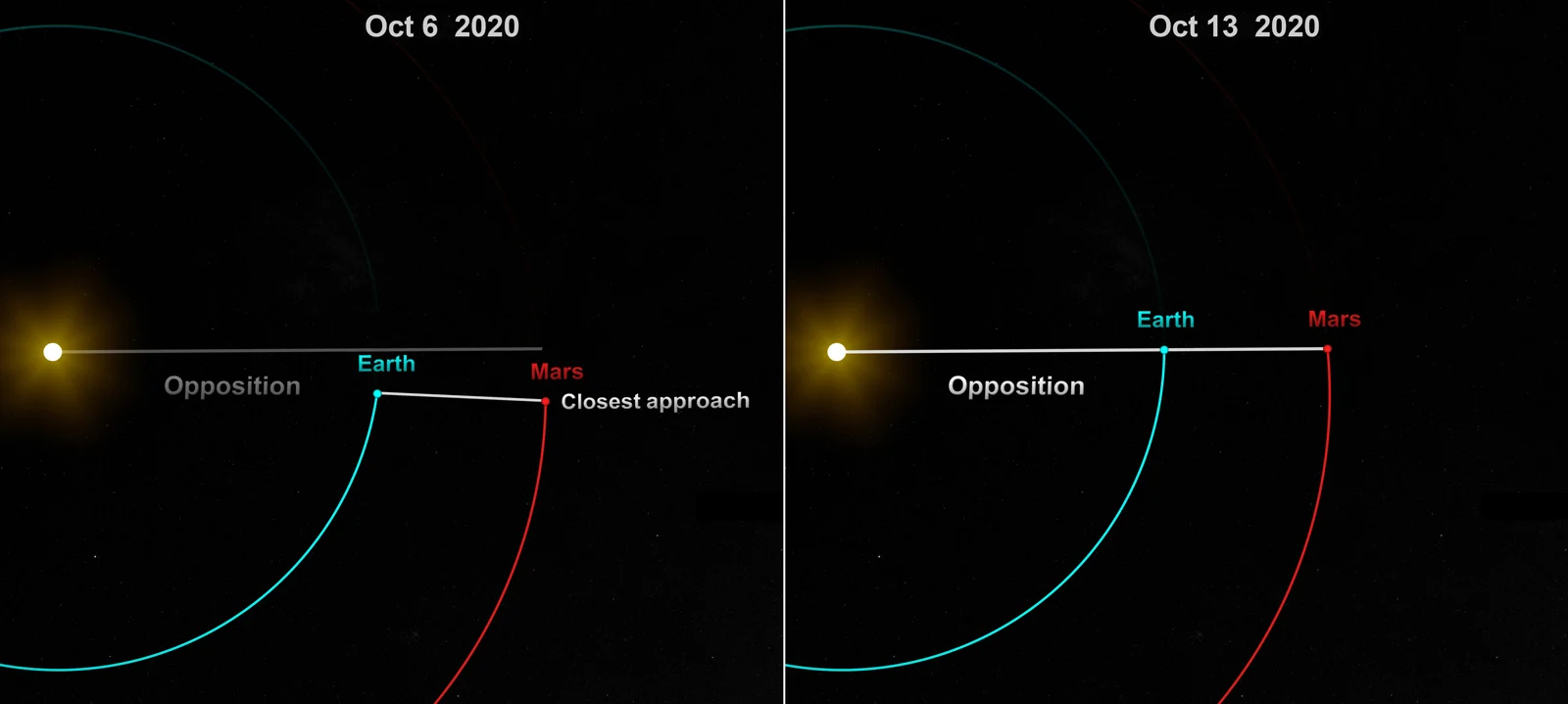
Mars closest approach vs Mars conjunction of 2020. Credit: NASA/Scott Sutherland
Why do these two dates not line up? It's due to Mars having a more elliptical orbit than Earth. The way the two orbits are oriented with respect to each other, the two planets' closest approach happens a week before Mars lines up on the opposite side of Earth from the Sun. In 2018, the closest approach was just a few days before Opposition. In 2016, Opposition occurred first, with the closest approach happening roughly a week later.
FIVE MINOR METEOR SHOWERS
Fall is a particularly active season when it comes to meteor showers!
A meteor shower occurs when Earth passes through a stream of fast-moving bits of dust or ice left behind by a comet or asteroid, and the planet's atmosphere sweeps up these meteoroids. These meteoroids produce bright streaks of light (meteors) as they compress and heat the atmospheric gases in their paths.
Five minor meteor showers peak during the autumn months. These are the Draconids on October 8, the Southern Taurids on October 10, the Orionids on October 21, the Northern Taurids on November 5 and the Leonids on November 16. Each of these showers produces maybe 10-20 meteors per hour, but this can vary from year to year. Due to this, they tend not to be very noteworthy events. However, dedicated meteor shower watchers who get far away from city lights can still catch these displays.
Of these, the Orionids, the Northern Taurids and the Leonids are well-timed with the Moon's phases. The rest can be seen, but the light from the Moon will wash out the dimmest meteors.
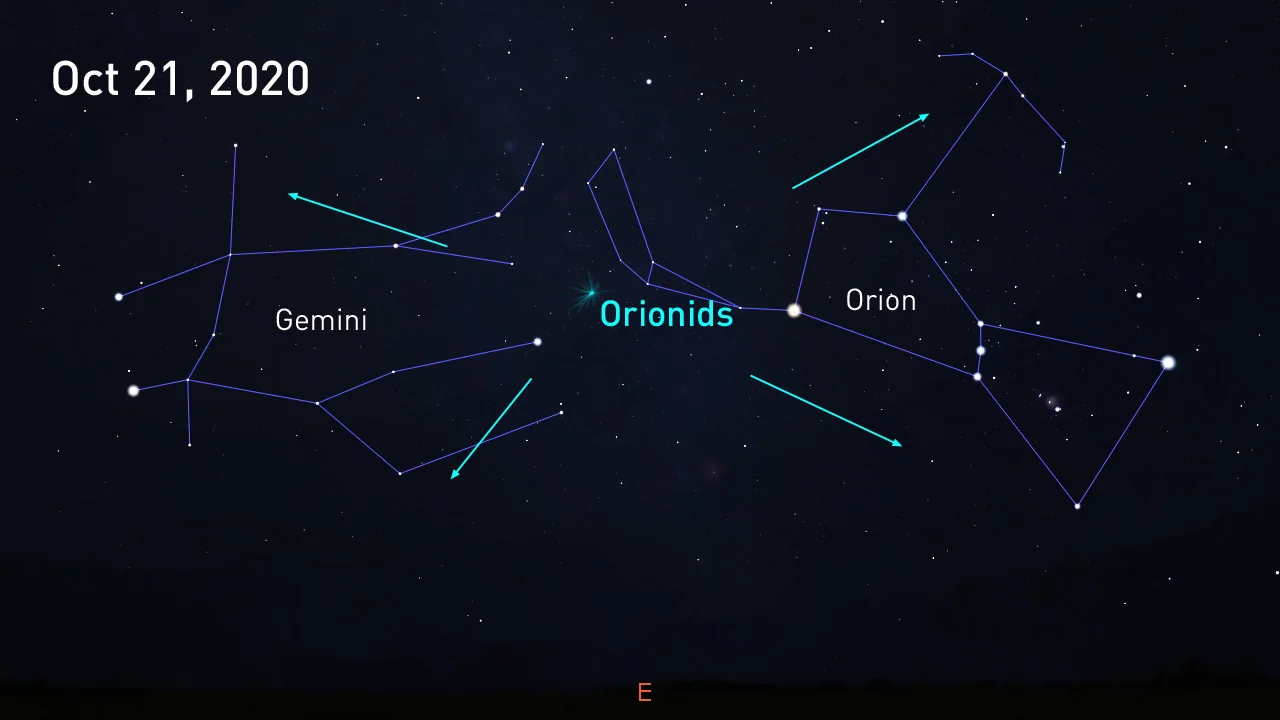
The radiant of the Orionids meteor shower, on October 21, 2020. Credit: Stellarium/Scott Sutherland
One thing of note: some meteor showers are known to cause a secondary phenomenon, known as persistent trains.
A persistent train forms when a meteoroid travels so fast that it strips away electrons from the air molecules in its path. These ionized air molecules linger along the meteoroid's path, and each one emits a brief burst of light when it picks up a replacement electron to neutralize that ionization. With so many molecules emitting this light, it shows up to us as a wispy, dimly-glowing ribbon in the sky, as the molecules are carried along by the wind. Trains are known to persist for some time after the meteor has gone out - from minutes to hours!
Watch below: RASC Victoria presents a Geminid meteor persistent train from 2014
Of the Fall meteor showers, the Leonids are the most well-known for producing persistent trains. As the video above shows, however, these phenomena can show up at any time, even during a slower meteor shower like the Geminids.
Scroll down for an in-depth guide on how to get the most out of watching meteor showers.
ZODIACAL LIGHT
Early risers will have a chance to spot an elusive phenomenon known as The Zodiacal Light.
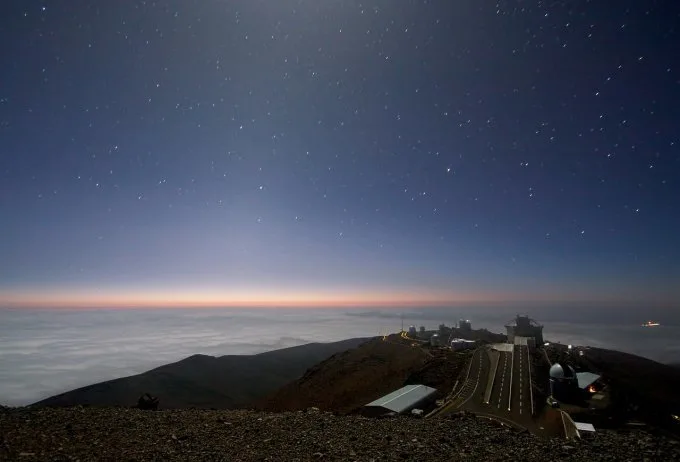
Moonlight and zodiacal light over La Silla. Credit: ESO
In the Royal Astronomical Society of Canada's 2020 Observer's Handbook, Dr. Roy Bishop, Emeritus Professor of Physics from Acadia University, wrote: "The zodiacal light appears as a huge, softly radiant pyramid of white light with its base near the horizon, and its axis centred on the zodiac (or better, the ecliptic). In its brightest parts, it exceeds the luminance of the central Milky Way."
The zodiacal light is caused by sunlight refracting off tiny bits of dust and ice that orbit around the Sun in the plane of the ecliptic (the same plane the planets orbit in). It is thought that this cloud originates from dust and ice blown off of comets.
According to Dr. Bishop, the light from this phenomenon is so diffuse that it can easily be spoiled by moonlight, haze or light pollution. Also, since it is best viewed just before twilight, inexperienced stargazers can sometimes confuse it for twilight and miss out.
Under clear, dark pre-dawn skies, look to the eastern horizon half an hour before twilight begins to show, from about October 14 through to around October 28.
The best mornings to see this phenomenon are likely around October 15-17, since those are the days around the New Moon, and there will be no chance of moonlight spoiling the attempt. Look for a pyramid-shaped white glow, with the base along the horizon and the point angled towards the south.
PENUMBRAL LUNAR ECLIPSE ACROSS CANADA
On the night of November 29-30, as the third mini Full Moon hangs in the night sky, it will dip into the lower half of Earth's shadow, resulting in a Penumbral Lunar Eclipse.
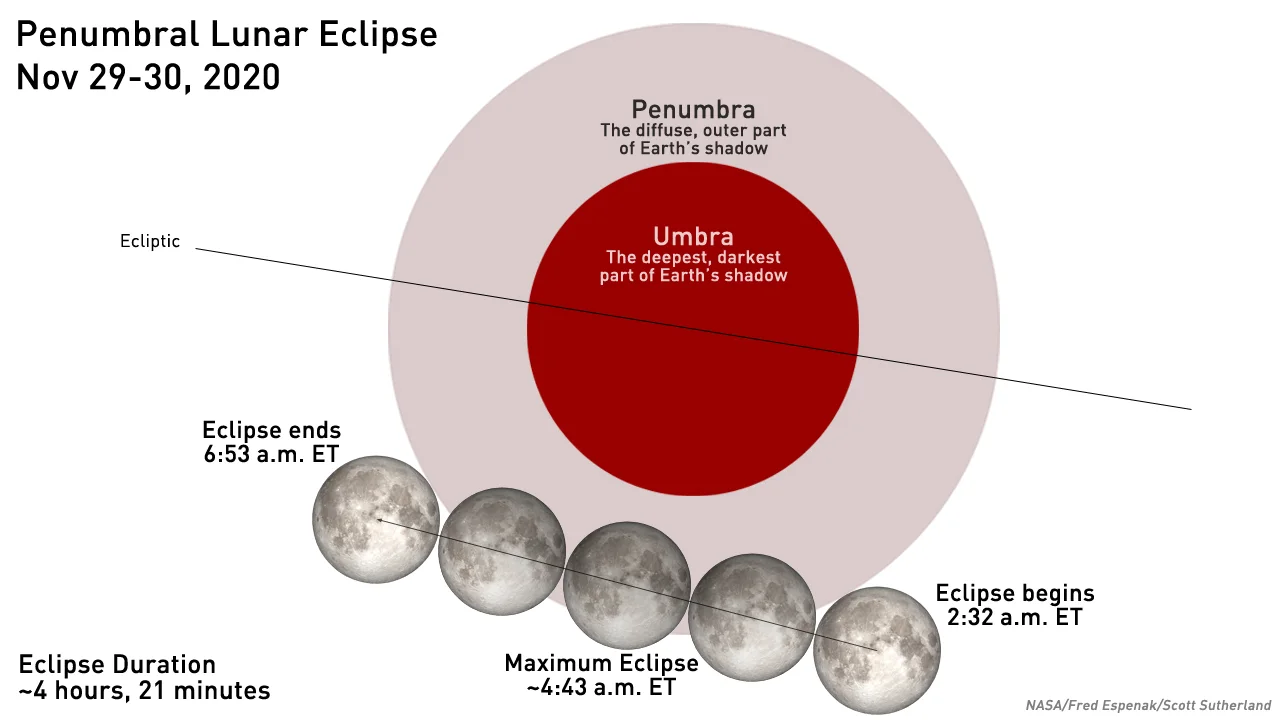
The path of the Full Moon through Earth's shadow. Credit: NASA/Fred Espenak/Scott Sutherland
Without the help of a telescope or a pair of binoculars, it isn't easy to see a penumbral lunar eclipse.
During a partial or total lunar eclipse, at least part of the Moon passes through the deep red inner part of Earth's shadow (aka the umbra). So, it is easy to spot the effects.
During a penumbral lunar eclipse, however, the Moon passes through the diffuse outer part of Earth's shadow (aka the penumbra). This doesn't cause a dramatic colour change, but instead just causes the Moon to dim slightly.
It takes a keen eye to spot this dimming, especially with the Moon farther away than usual, but it's worth a try.
GEMINID METEOR SHOWER PEAK
We've gone over the minor meteor showers above, but the Geminid Meteor Shower deserves its own entry.
The Geminid Meteor Shower is produced as Earth passes through a stream of dust and gravel left behind by the famous 'rock comet' 3200 Phaethon.
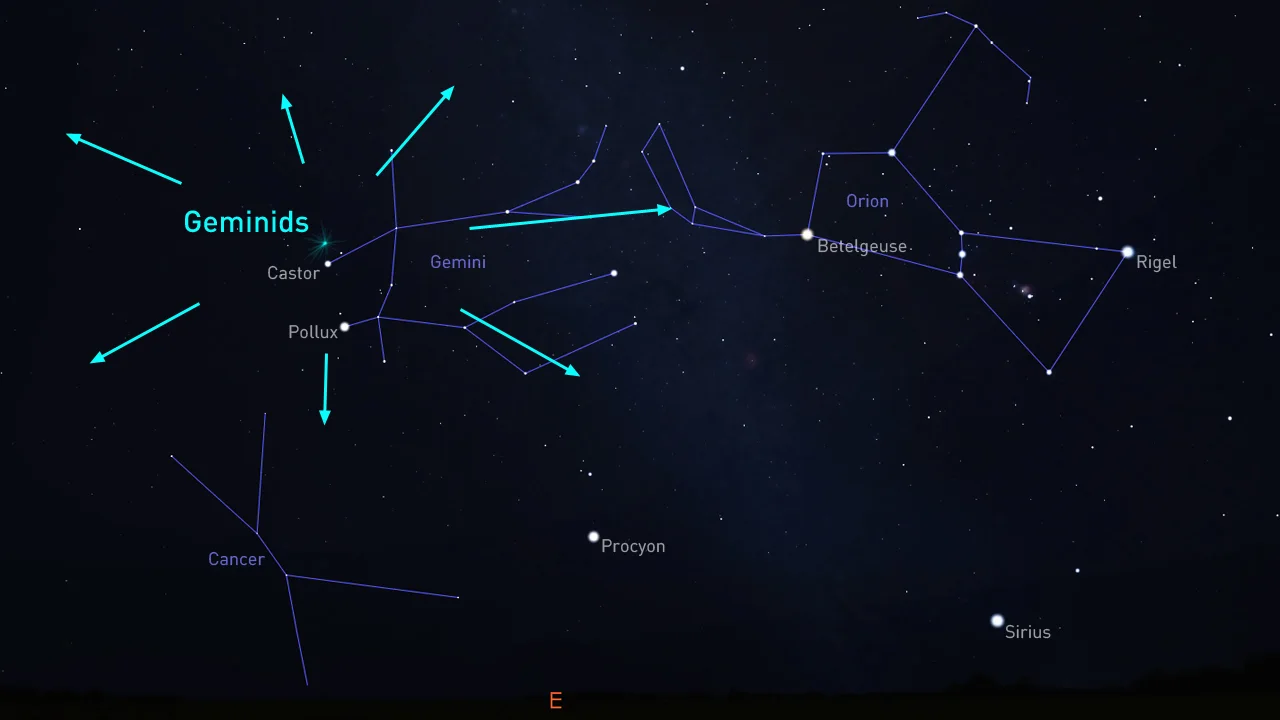
The radiant of the Geminid meteor shower, on the night of December 13-14. Credit: Stellarium/Scott Sutherland
The Geminids is one of the best meteor showers of the year, for three main reasons. 1) It produces the most meteors - averaging 120 per hour under clear skies and with dark sky conditions, 2) the grit and gravel from 3200 Phaethon produce multicoloured meteors when they hit the atmosphere, and 3) with the nights getting longer, there is more time during the night to see this meteor shower in action.
This year's Geminids, promises to be exceptionally good, due to the Moon. Last year, the timing of the shower's peak put it just one night after the Full Moon. This year, the shower peaks on the night of December 13-14, during the New Moon! Thus, there will be no natural light pollution to spoil the show!
What's a 'rock comet', you might ask? 3200 Phaethon is an asteroid that has an orbit similar to a comet - coming very close to the Sun, and then swinging far out into the asteroid belt before returning. When this massive space rock reaches its closest approach to the Sun, the intense heating blasts dust and grit off its surface. As this material continues to orbit along with the asteroid, it forms a meteoroid stream, similar to that of a comet.
TOTAL SOLAR ECLIPSE
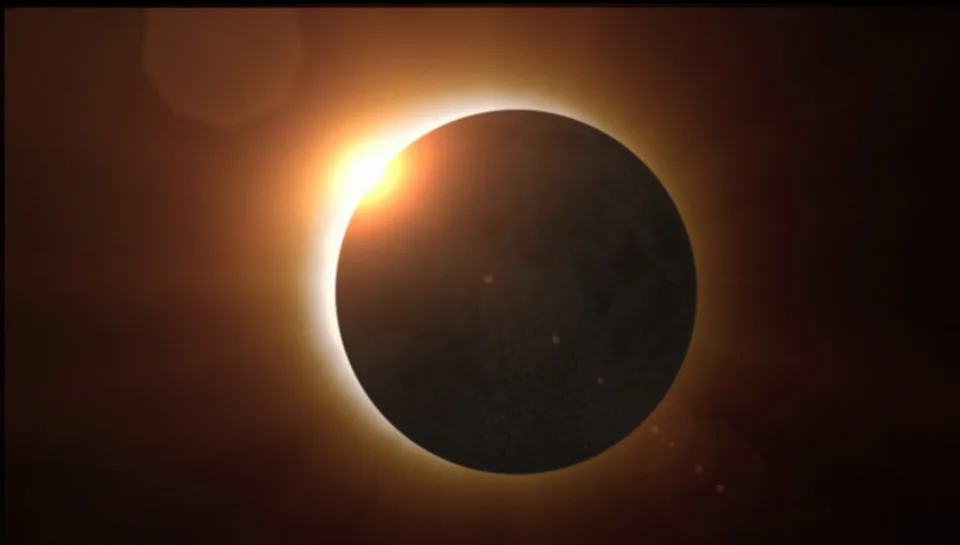
Credit: NASA
On the day of December 14, the New Moon will pass directly between the Earth and the Sun, to produce a Total Solar Eclipse.
This eclipse will not be directly visible from anywhere in Canada. It will only be seen in South America, with the 'path of totality' crossing central Chile and Argentina.

The path of totality of the Dec 14, 2020 Total Solar Eclipse. Credit: NASA/Fred Espenak
Even so, as we've seen with every such event in recent years, each has been streamed live on the internet. So, stand by in mid-December for more spectacular eclipse scenes from the southern hemisphere.
TIPS FOR STARGAZING & METEOR WATCHING
First, some honest truth: Many people who want to watch a meteor shower end up missing out on the experience, unnecessarily.
Since the Moon and most planets are so bright in the night sky, it's easy to fall into the expectation that watching a meteor shower will be just as easy. It takes a bit of travel and effort to get the most out of a meteor shower, but it is well worth it!
First off, there's no need to have a telescope or binoculars to watch a meteor shower. They'll actually make it harder to see the event because they restrict your field of view.
Here are the three 'best practices' for watching meteor showers:
Check the weather,
Get away from light pollution, and
Be patient.
Clear skies are very important for meteor-spotting. Even a few hours of cloudy skies can ruin an attempt to see a meteor shower. So, be sure to check The Weather Network on TV, on our website, or from our app, and look for my articles on our Space News page, just to be sure that you have the most up-to-date sky forecast.
Next, you need to get away from city light pollution. If you look up into the sky, are the only bright lights you see street lights or signs, the Moon, maybe a planet or two, and passing airliners? If so, your sky is just not dark enough for you to see any meteors. You might catch a bright fireball, but there's no guarantee, and those are typically few and far between. So, get out of the city, and the farther away you can get, the better!
Watch: What light pollution is doing to city views of the Milky Way
For most regions of Canada, getting out from under light pollution is simply a matter of driving outside of your city, town or village until a multitude of stars is visible above your head. In some areas, however, such as in southwestern and central Ontario, and along the St. Lawrence River, the concentration of light pollution is too high. Unfortunately, getting far enough outside of one city to escape its light pollution tends to put you under the light pollution dome of the next city over.
In these areas of concentrated light pollution, there are dark sky preserves. However, a skywatcher's best bet for dark skies is usually to drive north and seek out the various Ontario provincial parks or Quebec provincial parks. Even if you're confined to the parking lot, after hours, these are usually excellent locations from which to watch (and you don't run the risk of trespassing on someone's property).
Sometimes, based on the timing, the Moon is also a source of light pollution, and it can wash out all but the brightest meteors. We can't get away from the Moon, so we can just make do as best we can in these situations.
Once you've verified you have clear skies, and you've gotten away from light pollution, this is where having patience comes in.
For best viewing, you must give your eyes time to adapt to the dark. Give yourself at least 20 minutes, but the longer, the better. Just as a warning, if you skip this step, even if you follow the rest of the steps above, you will miss out on a lot of the action.
During this adjustment time, avoid all bright light sources - overhead lights, car headlights and interior lights, and cellphone and tablet screens. Any exposure to bright light during this period will cancel out some or all the progress you've made, forcing you to start over. Shield your eyes from light sources, and if you need to use your cellphone during this time, set the display to reduce the amount of blue light it gives off, and reduce the screen's brightness as much as possible. It may also be worth finding an app that puts your phone into 'night mode', which will shift the screen colours into the red end of the light spectrum, which has less of an impact on your night vision.
You can certainly look up into the starry sky while you are letting your eyes adjust. You may even see a few brighter meteors as your eyes become accustomed to the dark. If the Moon is shining brightly, turn so that it is out of your personal field of view.
Once you're all set, just look straight up!
Sources: IMO | RASC | NASA | With files from The Weather Network.











